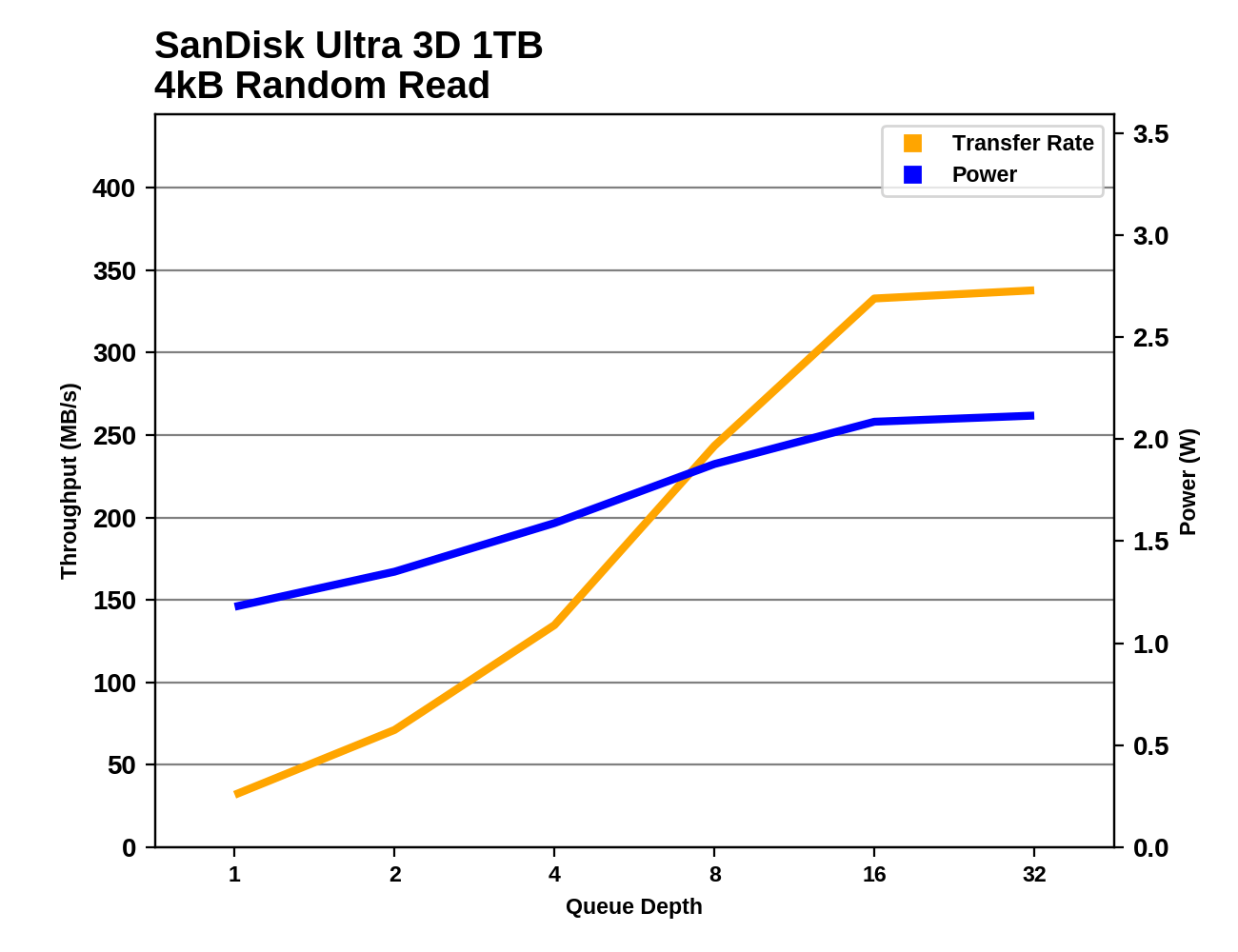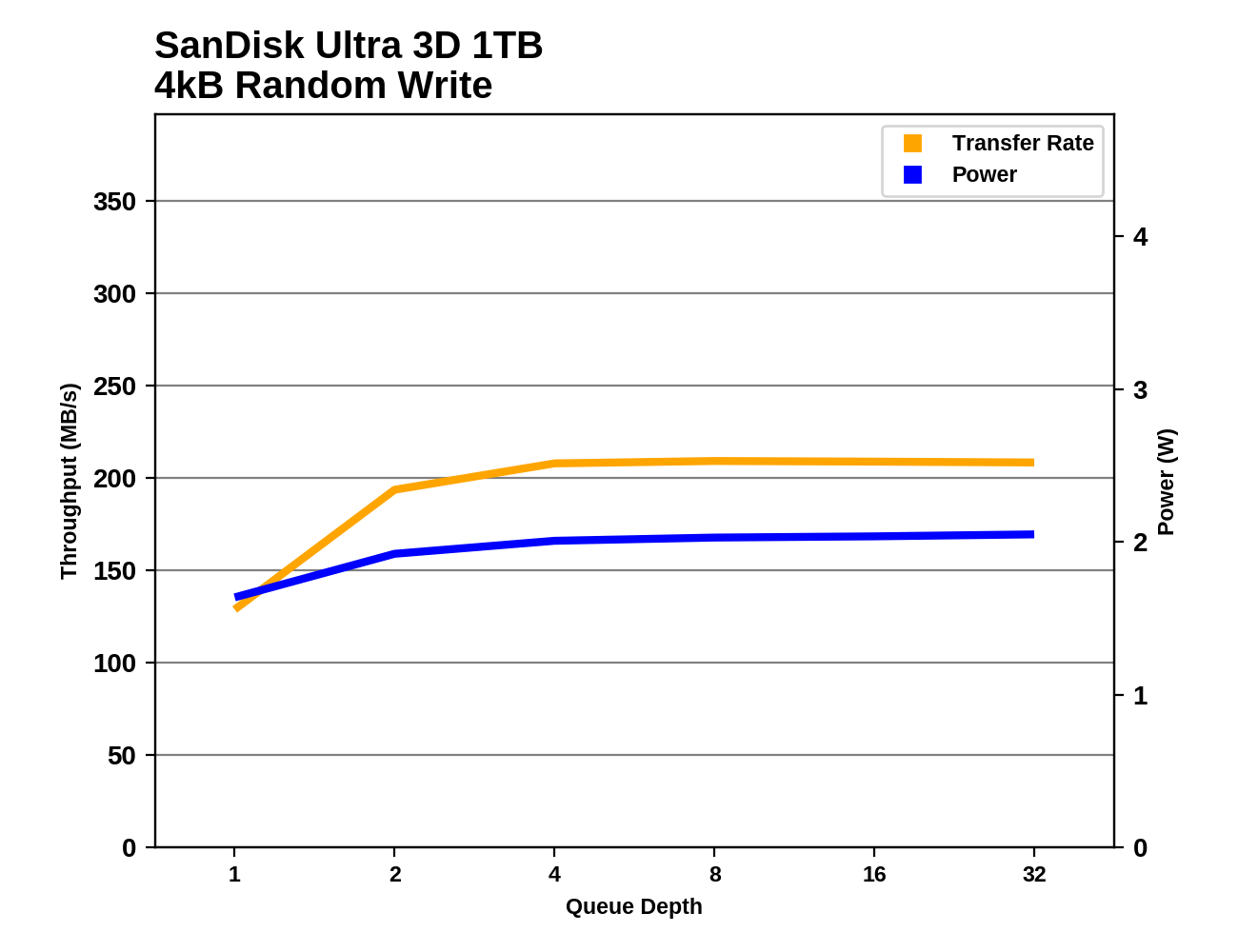One Design, Two Products: The SanDisk Ultra 3D (1TB) and WD Blue 3D (1TB) SSD Reviews, with BiCS 3D NAND
by Billy Tallis on September 14, 2017 9:00 AM ESTRandom Read Performance
Our first test of random read performance uses very short bursts of operations issued one at a time with no queuing. The drives are given enough idle time between bursts to yield an overall duty cycle of 20%, so thermal throttling is impossible. Each burst consists of a total of 32MB of 4kB random reads, from a 16GB span of the disk. The total data read is 1GB.

Orange is for the new drives, Blue is for the previous generation models
The switch to 3D NAND gives a clear boost to the random read performance of Western Digital's SSDs. The WD Blue was already in second place, but it has now narrowed the Samsung 850 PRO's lead.
Our sustained random read performance is similar to the random read test from our 2015 test suite: queue depths from 1 to 32 are tested, and the average performance and power efficiency across QD1, QD2 and QD4 are reported as the primary scores. Each queue depth is tested for one minute or 32GB of data transferred, whichever is shorter. After each queue depth is tested, the drive is given up to one minute to cool off so that the higher queue depths are unlikely to be affected by accumulated heat build-up. The individual read operations are again 4kB, and cover a 64GB span of the drive.

The performance boost from 3D NAND doesn't disappear on the longer random read test: the new Western Digital SSDs are able to hold on to second place, this time much closer to the Samsung 850 PRO in performance.

The WD/SanDisk drives already had great power efficiency for random reads, but the 3D NAND improves it even more. The Intel 545s still has the clear lead, but it isn't such a wide margin anymore.
 |
|||||||||
The performance scaling behavior of the SanDisk Ultra 3D and WD Blue 3D NAND are quite similar to other top-performing drives, with performance mostly saturated by QD16. The power consumption is much lower and scales more gradually than on Samsung's drives.
Random Write Performance
Our test of random write burst performance is structured similarly to the random read burst test, but each burst is only 4MB and the total test length is 128MB. The 4kB random write operations are distributed over a 16GB span of the drive, and the operations are issued one at a time with no queuing.

The older WD/SanDisk drives had some trouble with QD1 burst random write performance, but the new 3D NAND drives are as fast as any other TLC SATA SSDs on this test, and not too far behind the 3D MLC drives.
As with the sustained random read test, our sustained 4kB random write test runs for up to one minute or 32GB per queue depth, covering a 64GB span of the drive and giving the drive up to 1 minute of idle time between queue depths to allow for write caches to be flushed and for the drive to cool down.

On the longer test that brings in higher queue depths, the WD and SanDisk drives still fare poorly even with 3D NAND. Toshiba manages to deliver a better score with their OCZ Trion 150 using 15nm planar TLC, even though the Trion 150 was in last place for QD1 random write performance.

In spite of poor performance, the WD and SanDisk 3D NAND drives have good power efficiency that is on par with Samsung, but behind the Intel and Micron 3D NAND SSDs.
 |
|||||||||
Most of these SSDs reach their full random write performance by QD4 and don't gain anything from higher queue depths. The WD Blue 3D NAND and SanDisk Ultra 3D fit this description too, but with a remarkably sub-par performance at saturation.










52 Comments
View All Comments
Rictorhell - Friday, September 15, 2017 - link
Samsung is slated to announce an updated line of new m.2 NVME SSD's at some point this month or in the 4th quarter. Their current m.2 lineup maxes out at 2tb and I've been wondering if they will release a 4tb m.2, even at a sky-high price.Smell This - Thursday, September 14, 2017 - link
Sammy's 'Data Migration' & 'Magician' tools have been bullet-proof for me.Not sure about 'Acronis True Image WD Edition' ... Acronis True Image, surprisingly, has let me down on several occasions.
metayoshi - Friday, September 15, 2017 - link
I can only speak for myself, obviously, but I've been using Acronis True Image for years with no issue. I only use the most basic features like cloning disks and scheduled backups of full disks, but for those it works just fine.mapesdhs - Thursday, September 14, 2017 - link
Billy, any idea what causes those horrible latency spikes with the VX500? They're so big, I was surprised the commentary didn't mention it.Billy Tallis - Thursday, September 14, 2017 - link
Toshiba won't disclose controller architecture details, but all of the smaller capacities of the VX500 have no external DRAM, and the 1TB has only 256GB of external DRAM. We don't know how much memory is in the controller package itself, but the 1TB VX500 certainly has less memory than a typical mainstream SSD even though it's not truly DRAMless. The VX500 also uses SLC caching even though it's a MLC drive, and that tends to lead to greater performance variability (see the Crucial MX200).Glaring_Mistake - Thursday, September 14, 2017 - link
If I remember correctly the VX500 is entirely DRAMless for the smaller capacities that instead use a small amount of SRAM (think it's 32MB).But that was not enough for the 1TB drive so it differs from the other capacitites in that it has a small amount of DRAM at 256MB.
That is still just one fourth of the usual amount of DRAM used for a drive of that capacity however.
At any rate I believe that is the reason as to why latency may suffer a bit; not enough DRAM.
eddieobscurant - Friday, September 15, 2017 - link
"Meanwhile, the SanDisk Ultra 3D offers higher write endurance ratings and lower power consumption for a slightly lower price. The Ultra 3D makes more sense for most consumers."How does it make more sense? The average consumer won't even use the 1/5th of the endurance ratings, but choosing the extra 2 years of warranty of samsung makes a lot of more sense.
Adramtech - Sunday, September 17, 2017 - link
It's amusing to see people complain about the NAND & DRAM shortage and higher prices, and simutaneously say that there's "finally" something to compete with EVO. For years memory was so cheap it put scores of companies out of business and therefore less competition to compete with the EVO. If you want competitive products, these companies need to make money to drive multi-billion dollar Fab & R&D investments. Also, there is no price fixing, the AI revolution, big data, ADAS systems are eating up all the memory and storage. Not to mention HDDs switching over to SSD everywhere you look.kavita - Monday, September 18, 2017 - link
QA Testing the comments on Production.msroadkill612 - Monday, September 18, 2017 - link
Talk about tail wag the dog.That same expensive nand, can be rigged as 500MB/s sata ssd, OR, at about 5x+ that speed if the nvme (aka pcie ssdS) interface is used.
What a waste.
Why? Until very recent AMD TR, niggardly lane quotas on platforms (not unreasonably pre nvme ssdS) mean few have much room for devices that use 4 lanes each.
Sata only sells because its the port folks have readily available on their current pc. Even so, settling for 1/5 of an expensive devices capabilities seems rich.
i.e. - u r mad to buy sata.
Far better to try hard to find a way of improving your interface than settle for gimped ssdS.
Pcie3 nvme should be backwardly compatible w/ pcie2, so by running nvme on pcie2 lanes, they ares slower, but more than double the speed of, sata, and you have invested in a non gimped drives.
While i am at it, If I were buying a ryzen, my plan would be one of each. 2x nvme ssds, on a mobo like msi's am4 x370 moboS, w/ 2x onboard nvme ports, but due to ryzen lane limits, the second must be pcie2. It yields a very fast ssd, and a very, very fast ssd. Not bad.
Thats all your ryzen lanes used after the 16x lane gpu is counted, but u have stacks of ports on the chipset for other needs.
Far better to get an m.2 port pcie adaptor card, lanes permitting, and an nvme ssd.
It grates to hear common remark "oh, dont worry, you wont perceive the nvme speed difference". Yeah right.
The champ 960 pro 500GB nvme is rated for 3400GB/s read seq & 2250~GB/s write. Like u r not going to notice if an app ever swaps out to disk or works on scratch files at such differing relative speeds. BS.
Factor in also that sata ports from chipsets are handicapped in various ways, so it pays to investigate the exact nature of the sata port you use.
A notion for some lane starved users to consider is getting by with 8 lanes for your 16 lane gpu, thus freeing up a juicy 8x pcie3 lanes. Even some gamers credibly say it works as well. Google it.